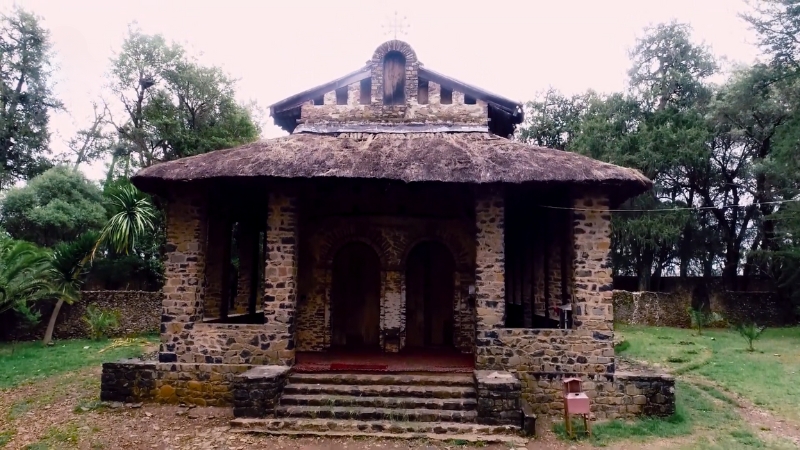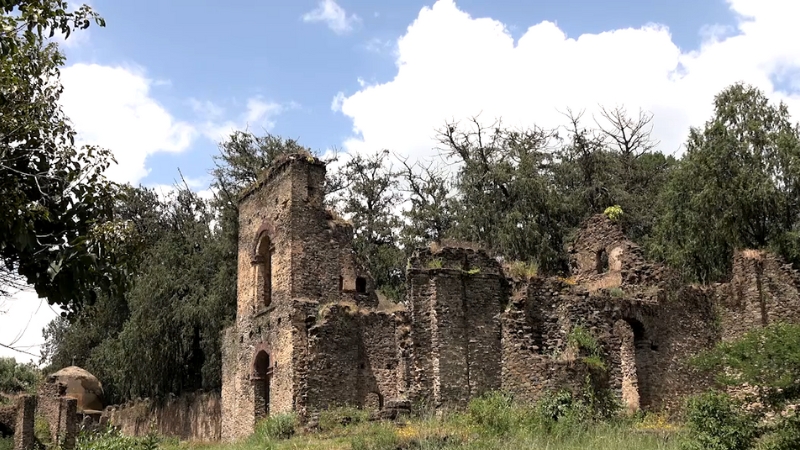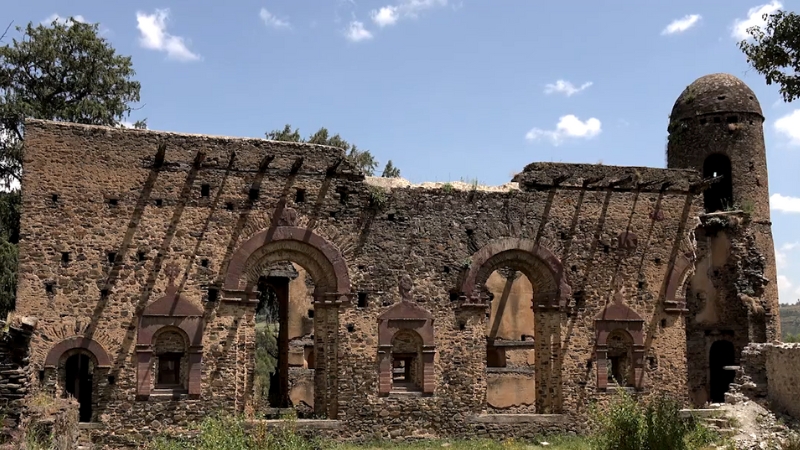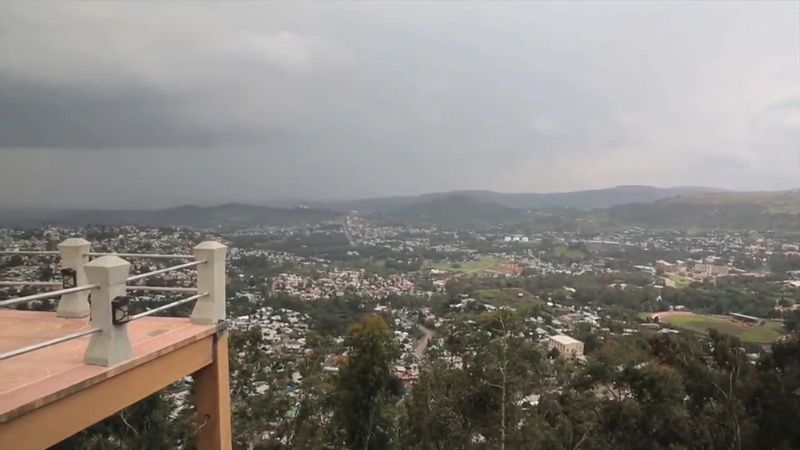Gondar is one of Ethiopia’s most important historical cities.
Once the capital of the Ethiopian Empire, it still holds some of the country’s best-preserved royal architecture, religious art, and cultural heritage sites.
Visitors come to Gondar for its castles, churches, and uniquely layered history that spans both the imperial and modern eras.
1. Fasil Ghebbi (Royal Enclosure)
This is Gondar’s most important historical site. Built by Emperor Fasilides in the 17th century, it functioned as Ethiopia’s imperial capital for nearly 200 years. Inside the massive stone walls, you’ll find several castles, royal libraries, banqueting halls, and courtyards built by different emperors.
The architecture reflects a unique blend of Ethiopian, Portuguese, and Indian styles.
Expect to spend 1.5 to 2 hours here. Guides are available at the gate and highly recommended, as most buildings are not labeled in detail.
Attribute
Details
Category
Fortress Complex (UNESCO World Heritage Site)
Location
Central Gondar
Construction Period
1636 to late 1700s
Entry Fee (2025)
Approx. 200 ETB for foreigners
Main Features
Fasilides’ Castle, Iyasu’s palace, royal library, lion cages, stables
Duration Needed
1.5 to 2 hours
Why Visit
It’s the core of Ethiopia’s imperial past; architecture is one-of-a-kind
2. Debre Berhan Selassie Church

This church is a must-see for its remarkable interior artwork. The ceiling is covered with more than 80 cherubic angel faces, all hand-painted in traditional Ethiopian Orthodox style.
The walls are covered with colorful biblical scenes, many of which have remained intact since the late 1600s. It’s the most famous painted church in the country and was the only one spared during the 19th-century invasions.
Dress modestly as it is an active place of worship. No flash photography allowed inside.
Attribute
Details
Category
Religious/Ethnic Art Site
Location
Northern Gondar, walkable from the town center
Construction Period
Late 17th century (Emperor Iyasu I era)
Entry Fee (2025)
Approx. 150 ETB
Main Features
Painted ceiling, biblical murals, large central dome
Duration Needed
45 minutes to 1 hour
Why Visit
The most iconic example of Ethiopian Christian art in its original form
3. Fasilides’ Bath (Fasil’s Pool)
View this post on Instagram
Though technically a historical site, this large rectangular pool is still in use today, especially during Timket, the Ethiopian Epiphany, when it’s filled with water and thousands gather for a re-enactment of Christ’s baptism.
The surrounding fig trees and ceremonial house built into the wall make this a serene and atmospheric spot to visit, even outside of festivals.
There’s little signage, so a quick guide or background info is helpful for context. It’s less crowded than Fasil Ghebbi and can be visited in under an hour.
Attribute
Details
Category
Historical Religious Pool
Location
West of the Royal Enclosure, approx. 1.5 km
Construction Period
17th century, under Emperor Fasilides
Entry Fee (2025)
Approx. 100 ETB
Main Features
Large stone pool, ceremonial towers, shaded fig trees
Duration Needed
30–45 minutes
Why Visit
Important active religious site; beautiful during the Timket festival
4. Kuskuam Complex

The Kuskuam Complex is a historical site built in the 1730s by Empress Mentewab, one of the most powerful royal women in Ethiopian history. She commissioned the complex as a personal retreat and religious center after the death of her husband, Emperor Bakaffa.
The site is located on Kuskuam Hill, about 3 kilometers outside the city center of Gondar, and is surrounded by eucalyptus forests and quiet pathways.
The complex includes the ruins of a palace, an old monastery, and Qusquam Mariam Church, which serves as Mentewab’s burial site. Although many of the structures have deteriorated, key parts of the architecture are still standing, including stone walls, arches, and foundations.
There are no extensive preservation efforts, so the ruins remain in a raw, original state, which adds to the authenticity of the site.
Most visitors combine this with a visit to the church and tomb within the same area. The setting is quiet and rarely crowded, making it ideal for visitors seeking a less commercialized experience.
Attribute
Details
Category
Royal retreat and religious site
Location
3 km outside Gondar, on Kuskuam Hill
Built
1730s
Entry Fee (2025)
100 ETB
Main Features
Palace ruins, monastery remains, forested setting
Duration Needed
1 to 1.5 hours
Why Visit
Historical site tied to Empress Mentewab’s independent political role
5. Empress Mentewab’s Castle
a few more palaces <castles> at gondar built in the same style as Fasilides at fasil ghebbi <nubian ,baroque indian (?)>
Empress Mentewab’s Castle 1750
Emperor Iyasu’s palace 1690s
Chancellery of Yohannes 1667 (?)
Castle of Bakaffa 1721 (?) #historyxthttps://t.co/whPZKoTbx4 pic.twitter.com/XVFNdFYiCC— isaac Samuel (@rhaplord) June 3, 2018
Inside the Kuskuam Complex, Empress Mentewab’s Castle served as her residence during her later life. The structure is partially intact, with visible stone arches, open courtyards, and remnants of royal rooms.
The castle was part of a larger movement during her reign to establish political and religious autonomy, particularly in the face of resistance from other imperial factions.
The building demonstrates a blend of local and foreign architectural styles, though only parts of it remain standing. From the elevated platform, you can look out over the surrounding countryside.
There are no guided tours or signage, so prior knowledge or a local guide is useful for context.
Attribute
Details
Category
Royal castle ruin
Location
Within Kuskuam Complex
Built
Mid-18th century
Entry Fee (2025)
Included with Kuskuam admission
Main Features
Arched entrances, collapsed walls, elevated views
Duration Needed
30–45 minutes
Why Visit
Historic royal residence of Ethiopia’s most influential empress
6. Qusquam Mariam Church

This church is located next to Mentewab’s castle and remains a functional religious site under the Ethiopian Orthodox Tewahedo Church. Built in the mid-1700s, it is most notable as the burial place of Empress Mentewab, making it one of the most historically significant Orthodox churches in the area.
The church structure is modest in design, made of stone and wood, without the elaborate interior painting seen in Debre Berhan Selassie.
However, it has a quiet and dignified atmosphere, enhanced by the surrounding greenery and the low number of visitors. Worshippers still attend services here, so respectful dress and quiet behavior are required.
Attribute
Details
Category
Church and historical burial site
Location
Inside Kuskuam Complex
Built
Mid-18th century
Entry Fee (2025)
Included with Kuskuam Complex
Main Features
Tomb of Empress Mentewab, church courtyard, simple design
Duration Needed
30–40 minutes
Why Visit
Burial site of a key figure in Ethiopian religious and royal history
7. Gondar Synagogue (Wolleka Village)
View this post on Instagram
Located in Wolleka Village, about 5 km from central Gondar, this site represents the remaining traces of the Beta Israel (Ethiopian Jewish) community. Most of the community emigrated to Israel in the 1980s and 1990s during mass airlift operations, but the synagogue, Jewish cemetery, and heritage plaques remain.
The synagogue is simple, with wooden benches and Hebrew texts still visible. A few local caretakers and artisans live in the area and may offer guided explanations. It is one of the very few Jewish heritage landmarks still standing in Ethiopia.
Attribute
Details
Category
Jewish religious and cultural heritage
Location
Wolleka Village, 5 km from Gondar
Built
20th century
Entry Fee (2025)
~50 ETB donation
Main Features
Synagogue, cemetery, heritage signs, traditional homes
Duration Needed
45–60 minutes
Why Visit
Rare public reminder of Ethiopia’s Jewish community history
8. Goha Hotel Viewpoint

Located at the top of Goha Hill, this viewpoint is accessible by vehicle or on foot and offers the best panoramic view of Gondar and the surrounding highlands. You don’t need to stay at the hotel to access the open-air terrace, but staff may ask that visitors purchase a drink or small item if they’re not guests.
This is the ideal place to watch the sunset or take wide-angle photos of the Royal Enclosure, Debre Berhan Selassie, and the rolling hills that surround the city. It’s also a good rest stop after a full day of touring.
Attribute
Details
Category
Scenic overlook
Location
Top of Goha Hill, west of Gondar center
Built
Mid-20th century (hotel opened); viewpoint is always accessible
Entry Fee (2025)
Free (or cost of a drink/snack if entering the hotel café)
Main Features
City panorama, mountain backdrop, hotel terrace
Duration Needed
30–60 minutes
Why Visit
Best elevated view of Gondar for photos or a relaxing break
Conclusion
If you’re short on time, Fasil Ghebbi, Debre Berhan Selassie Church, and Fasilides’ Bath are your top three. They form the core of Gondar’s historical identity — a royal compound, a religious masterpiece, and a still-active ceremonial site. These are non-negotiable if you’re serious about understanding the city.
For a deeper experience, Kuskuam Complex and its connected sites — Mentewab’s Castle and Qusquam Mariam Church — offer a quieter but equally important look at Ethiopia’s imperial legacy, especially from the perspective of a female ruler.
Exploring Gondar is one of the most rewarding things to do in Ethiopia if you’re interested in both ancient history and cultural depth.
Meanwhile, Wolleka’s Gondar Synagogue is one of the last physical traces of the Beta Israel (Ethiopian Jewish) community and is worth visiting for its cultural significance alone.
